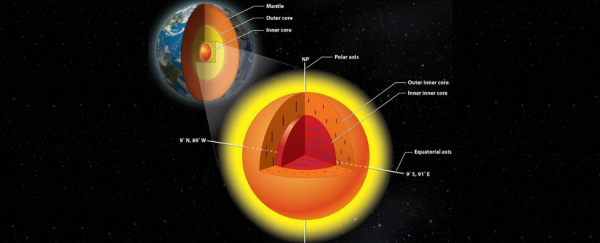Scientists have used echoes produced by earthquakes to gain new insights into what's going on right at the centre of the Earth, and suggest that the central core is actually split into two sections.
Conventional wisdom says that the Earth is made of of several layers - like an onion - consisting of the solid, outer silicate crust; the viscous mantle; the liquid outer core; and the inner core, made up of a solid ball of iron. If we wanted to see what was going on right down there in the core, we'd have to drill at least 5,000 kilometres into the Earth, which isn't exactly feasible - the deepest we've ever gone is 12.262 km, which is a mere 0.2 percent of the distance down to the inner core. So scientists have to use more indirect methods to figure out what's down there.
By looking at how earthquake echoes change as they travel back and forth from one side of the Earth to the other, scientists now suspect that the iron crystals in the centre and on the outside of the inner core have very different structures. So much so, that it looks like the newly proposed 'inner inner core' takes up about half the diameter of the entire inner core, with its iron crystals pointing in an east-to-west direction. The iron crystals in the outer inner core, on the other hand, appear to be pointing north-to-south.
And not only are the iron crystals in the outer and inner inner core aligned differently, but they also appear to behave differently too, the researchers report, which means that these two different core layers could be made up of different types of crystals. Perhaps, they say, these different structures and behaviours can tell us more about the turbulent period of formation that the Earth underwent 4.6 billion years ago, and what the inner core is going to do next. We know that it's growing about 0.05 mm each year, but how will this change things on a larger scale in the future?
"The fact that we have two regions that are distinctly different may tell us something about how the inner core has been evolving," one of the team, geologist Xiaodong Song from the University of Illinois in the US, said in a press release. "For example, over the history of the Earth, the inner core might have had a very dramatic change in its deformation regime. It might hold the key to how the planet has evolved. We are right in the centre - literally, the centre of the Earth."
The results have been published in the journal Nature Geoscience.
"People have noticed differences in the way seismic waves travel through the outer parts of the inner core and its innermost reaches before, but never before have they suggested that the alignment of crystalline iron that makes up this region is completely askew compared to the outermost parts," geologist Simon Redfern from the University of Cambridge in the UK, who was not involved in the research, told Rebecca Morelle at BBC News. "If this is true, it would imply that something very substantial happened to flip the orientation of the core to turn the alignment of crystals in the inner core north-south as is seen today in its outer parts."
Source: BBC News
